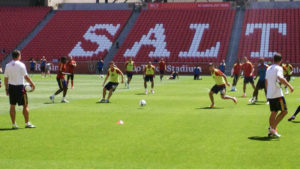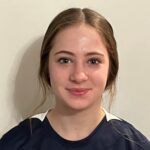Overlap season spreads kids thin: The 6+ program to prevent over-training injuries
 When my daughter’s team hit the fields for the spring season tune up, I was happily surprised by the healthy depth of their roster. I keep track of this stuff, as a mom and a sports medicine professional keeping a close eye on the injury tally. “Just wait,” her coach cautioned, “spring is overlap season. Kids play high school and club. The injuries will come.”
When my daughter’s team hit the fields for the spring season tune up, I was happily surprised by the healthy depth of their roster. I keep track of this stuff, as a mom and a sports medicine professional keeping a close eye on the injury tally. “Just wait,” her coach cautioned, “spring is overlap season. Kids play high school and club. The injuries will come.”
And they did. The kids made their JV or varsity high school teams and doubled up on practices. Two or so hours after school with one team then, and with a quick snack stop-over at home, they headed out to evening club practice two or three evenings a week. Homework started at 9 or 10 p.m., finished at 1 or 2 a.m., and then 4 hours later they were up to do it all over again.
And that was just the beginning. Pour on the game days: weekday evenings for high schoolers, often mandated to stay for the “other” game (JV if they were varsity and vice versa), and perhaps both days of a weekend, with travel included for club competitions, regional play, etc.
It was no wonder that injuries were right around the corner. Let’s look at what’s wrong here:
- Not enough sleep
- Not eating well
- Four to five hours per day training
- Three to five games a week
- Homework done in the car, on the bus, in bed
- Social? Not much, unless teammates are best friends
No body is meant to perform to these standards, not even the most fit or the most healthy. But, we’re doing it again, rolling into overlap season in Virginia. High school tryouts have just concluded for most, leaving many kids already hobbling, yet hoping they have made their high school teams.
High school tryouts are a curious entity to me. Many schools offer “preseason conditioning” which is optional, and some clubs offer winter high school prep programs, but these do not prepare the kids for the weed-out wind sprints and suicides and running of stairs that befall them at the close of tryout sessions.
Kids tell me it almost seems an afterthought to the coaches: “Oh look. We have some extra time here. Why don’t we run some sprints?”
True, the kids who are out of shape will fall away. But can we not gather feedback about their fitness without injuring them? Recovery heart rates are a perfectly good measure. Perceived exertion is an excellent self-feedback mechanism. Even, simple collection of recorded times or duration in a standard beep test provide accurate fitness information without killing them. All these are tools a diligent coach should have at his or her disposal. “Last player standing” is not a great team strategy.
Yes, it would have been better if they had all showed up fit and ready to go. That is the best injury prevention mechanism I know. But, absent this, we need to know the difference between a push which will improve them and a shove will send them right over the edge. To know that requires getting to know the kids.
And they have pretty full plates. Making the high school team just piles it higher. Very likely that means — at least in Virginia and other states and regions where high school soccer is played in the spring — that high school and club soccer will compete for their time, their sleep, their nutrition, their social life and their grades. That’s a lot of competition! Something’s got to give.
That shouldn’t be our kids, because we’re doing it for them, right? Without them, we don’t have the team; we don’t have the game; we don’t have the championship. So let’s all start there: We ALL want healthy, strong kids to play on our teams. How can we handle the overlap with that in mind?

Here’s the Fit2Finish coaches list to preempt overlap injuries:
- Issue a preseason form to each player to obtain information about: previous injuries, current issues, any other team participating with, contact information for coach of the other team.
- Before practices and games, offer correct and sufficient warm up — not just laps to raise temperature, but neuromuscular to tune in body connections.
- Carefully design each practice. Know what kind of demands you are placing on your players. Is it hard on the muscles? Which ones? Is it a challenge to the heart? How challenging? Don’t challenge the same muscles or the same energy systems on consecutive days. Embrace your own cross training program. Toss in some work on re-starts and set plays for recovery days.
- Don’t forget core muscle work. This takes a load off of hard-working legs and pays dividends in stronger, easier whole body movement, coordination and confidence.
- Attend to minor aches and pains of athletes. Help them learn to distinguish between muscle soreness and pain that spells injury.
- Teach players to monitor the training zone they are in. Perceived exertion on the 1-10 scale is reliable and a great self-assessment technique. Or use the green-yellow-red zone approach: Green means good to go. Yellow means proceed with caution. Red means please pull back into yellow.
This is a complete arsenal if you’re the kids’ only coach. But, during overlap season, it’s likely you will be sharing players with other coaches you may or may not know. Now, you’ve got the contact information for that coach; call, email or text to coordinate the training of the player you share. Individualizing that training is the most important thing you can do for the long-term development of that player. Fail there and everyone loses out on the best play available from this kid.
Just be sure to communicate this to the rest of the team. You’re not playing favorites. This is your game plan: each player, according to what he or she needs to play his or her best. Doesn’t that sound like a winning combination? And the respect it grows will pay dividends long after this season.
SOCCERWIRE MARKETPLACE
- The St. James FC Virginia 2024-2025 Travel Tryouts
- TSJFCV - Hiring Travel Soccer Coaches
- Hiring: U13-U19 Boys Director
- Coaches Needed
- Train with professional AC Milan coach
- Loudoun Soccer 2024/25 Travel Player Placement Sessions
- Official Elite Summer Soccer Camps with Elite Pro Clubs in Europe
- Official EPL Tickets: ARSENAL, LIVERPOOL, TOTTENHAM & MORE
- Travel to Denmark for Dana Cup Hjørring 2024
- New England Surf Challenge and Showcase 2024











